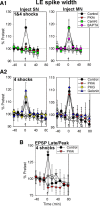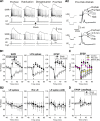Presynaptic and postsynaptic mechanisms of synaptic plasticity and metaplasticity during intermediate-term memory formation in Aplysia
- PMID: 20410130
- PMCID: PMC6632334
- DOI: 10.1523/JNEUROSCI.4947-09.2010
Presynaptic and postsynaptic mechanisms of synaptic plasticity and metaplasticity during intermediate-term memory formation in Aplysia
Abstract
Synaptic plasticity and learning involve different mechanisms depending on the following: (1) the stage of plasticity and (2) the history of plasticity, or metaplasticity. However, little is known about how these two factors are related. We have addressed that question by examining mechanisms of synaptic plasticity during short-term and intermediate-term behavioral sensitization and dishabituation in a semi-intact preparation of the Aplysia siphon-withdrawal reflex. Dishabituation differs from sensitization in that it is preceded by habituation, and is thus a paradigm for metaplasticity. We find that whereas facilitation during short-term sensitization by one tail shock involves presynaptic covalent modifications by protein kinase A (PKA) and CamKII, facilitation during intermediate-term sensitization by four shocks involves both presynaptic (PKA, CaMKII) and postsynaptic (Ca(2+), CaMKII) covalent modifications, as well as both presynaptic and postsynaptic protein synthesis. The facilitation also involves presynaptic spike broadening 2.5 min after either one or four shocks, but not at later times. Dishabituation by four shocks differs from sensitization in several ways. First, it does not involve PKA or CaMKII, but rather involves presynaptic PKC. In addition, unlike sensitization with the same shock, dishabituation by four shocks does not involve protein synthesis or presynaptic spike broadening, and it also does not involve postsynaptic Ca(2+). These results demonstrate that not only the mechanisms but also the site of plasticity depend on both the stage of plasticity and metaplasticity during memory formation.
Figures






Similar articles
-
Whereas short-term facilitation is presynaptic, intermediate-term facilitation involves both presynaptic and postsynaptic protein kinases and protein synthesis.Learn Mem. 2011 Jan 18;18(2):96-102. doi: 10.1101/lm.1949711. Print 2011 Feb. Learn Mem. 2011. PMID: 21245210 Free PMC article.
-
New tricks for an old slug: the critical role of postsynaptic mechanisms in learning and memory in Aplysia.Prog Brain Res. 2008;169:277-92. doi: 10.1016/S0079-6123(07)00017-9. Prog Brain Res. 2008. PMID: 18394481 Free PMC article. Review.
-
Synaptic facilitation and behavioral dishabituation in Aplysia: dependence on release of Ca2+ from postsynaptic intracellular stores, postsynaptic exocytosis, and modulation of postsynaptic AMPA receptor efficacy.J Neurosci. 2005 Jun 8;25(23):5623-37. doi: 10.1523/JNEUROSCI.5305-04.2005. J Neurosci. 2005. PMID: 15944390 Free PMC article.
-
The contribution of facilitation of monosynaptic PSPs to dishabituation and sensitization of the Aplysia siphon withdrawal reflex.J Neurosci. 1999 Dec 1;19(23):10438-50. doi: 10.1523/JNEUROSCI.19-23-10438.1999. J Neurosci. 1999. PMID: 10575041 Free PMC article.
-
Cellular, molecular, and epigenetic mechanisms in non-associative conditioning: implications for pain and memory.Neurobiol Learn Mem. 2013 Oct;105:133-50. doi: 10.1016/j.nlm.2013.06.008. Epub 2013 Jun 22. Neurobiol Learn Mem. 2013. PMID: 23796633 Free PMC article. Review.
Cited by
-
Autocrine signaling by an Aplysia neurotrophin forms a presynaptic positive feedback loop.Proc Natl Acad Sci U S A. 2018 Nov 20;115(47):E11168-E11177. doi: 10.1073/pnas.1810649115. Epub 2018 Nov 5. Proc Natl Acad Sci U S A. 2018. PMID: 30397154 Free PMC article.
-
Learning and memory in zebrafish larvae.Front Neural Circuits. 2013 Aug 2;7:126. doi: 10.3389/fncir.2013.00126. eCollection 2013. Front Neural Circuits. 2013. PMID: 23935566 Free PMC article. Review.
-
Successful and unsuccessful attempts to swallow in a reduced Aplysia preparation regulate feeding responses and produce memory at different neural sites.Learn Mem. 2019 Apr 16;26(5):151-165. doi: 10.1101/lm.048983.118. Print 2019 May. Learn Mem. 2019. PMID: 30992384 Free PMC article.
-
Concepts of scientific integrative medicine applied to the physiology and pathophysiology of catecholamine systems.Compr Physiol. 2013 Oct;3(4):1569-610. doi: 10.1002/cphy.c130006. Compr Physiol. 2013. PMID: 24265239 Free PMC article. Review.
-
The vertical lobe of cephalopods: an attractive brain structure for understanding the evolution of advanced learning and memory systems.J Comp Physiol A Neuroethol Sens Neural Behav Physiol. 2015 Sep;201(9):947-56. doi: 10.1007/s00359-015-1023-6. Epub 2015 Jun 26. J Comp Physiol A Neuroethol Sens Neural Behav Physiol. 2015. PMID: 26113381 Review.
References
-
- Abraham WC, Bear MF. Metaplasticity: the plasticity of synaptic plasticity. Trends Neurosci. 1996;19:126–130. - PubMed
-
- Antonov I, Antonova I, Kandel ER, Hawkins RD. Activity-dependent presynaptic facilitation and Hebbian LTP are both required and interact during classical conditioning in Aplysia. Neuron. 2003;37:135–147. - PubMed
Publication types
MeSH terms
Grants and funding
LinkOut - more resources
Full Text Sources
Medical
Miscellaneous
